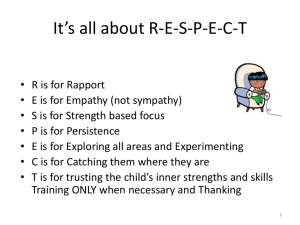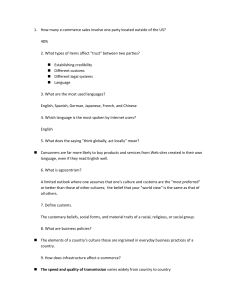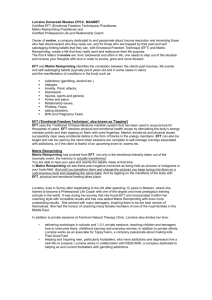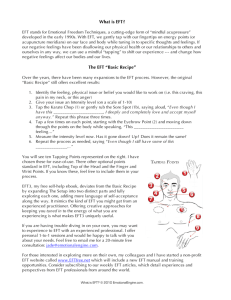Wind storm research at HZG - Coordination of storm themes Matthias Zahn
advertisement
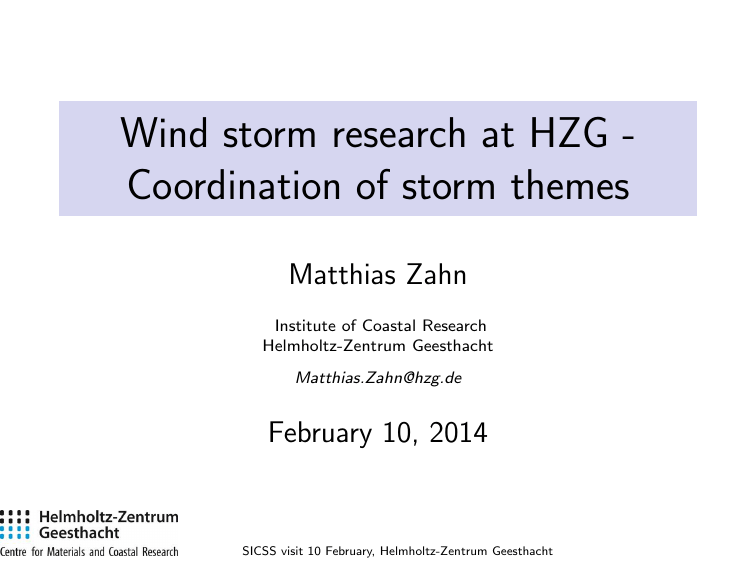
Wind storm research at HZG Coordination of storm themes Matthias Zahn Institute of Coastal Research Helmholtz-Zentrum Geesthacht Matthias.Zahn@hzg.de February 10, 2014 SICSS visit 10 February, Helmholtz-Zentrum Geesthacht Focus of research: maritime storms over the world oceans, extra tropical storms Focus of research: maritime storms over the world oceans, typhoons Focus of research: maritime storms over the world oceans, polar lows Focus of research: maritime storms over the world oceans, medicanes Current members of HZG with emphasis on storm themes: ◮ ◮ ◮ ◮ ◮ ◮ Dr.Frauke Feser, leader Dr.Matthias Zahn, detection and tracking Martina Schubert-Frisius, model simulations Svenja Bierstedt, long-term changes along the Baltic coastline Delei Li, Bohai and Yellow Sea Benjamin Schaaf, extra tropical storms and their coastal impacts in the North Sea Tools of research: numerical models dynamical downscaling different types of models of the atmosphere/ocean, used in so called model chains Why models? ◮ ◮ ◮ ◮ homogeneity spatially extended information long in time future scenarios Example of recent research: polar lows ◮ ◮ ◮ ◮ ◮ ◮ diameter < 1000km strong winds > 13.9 ms heavy precipitation poleward Polar Fronts in winter spiral cloud and cloud free core (Arctic Hurricane) rapid development c Dundee Satellite Receiving Station Used here: Regional Climate Model Model grid ◮ ◮ ◮ 60 years of NCEP/NCAR reanalysis data downscaled using COSMO-CLM-2.4.6. spectral nudging applied Example of a reproduced PL case 15 Oct 1993, 6:00, The Swan Example of a reproduced PL case 15 Oct 1993, 6:00, The Swan How to detect storms? Spatial filter! (a) full field (b) low pass (c) band pass (d) high pass Example of band-pass filtered MSLP 200-600km retained, PLs emerge as distinct minima Dec 1993 case 2 1 & A 6 5 ;; A +*#$*+%. #0 // 5 ;; 6 & Jan 1998 case & & A #3*#*+3. ( // 5 )- 5 )- 6 & Detection and tracking scheme 1. record all locations at which filt. MSLP minimum ≤ −1hPa 2. combine detected positions to individual tracks, distance to next (3h) pos ≤ 200km 3. checking further constraints along tracks: ◮ ◮ ◮ ◮ ◮ filt. minimum ( ≤ −2hPa once along track) wind speed (≥ 13.9 ms once along track) air-sea temperature difference (SST − T500hPa ≥ 43K ) no northward direction of track limits to allowable adjacent grid boxes OR: minimum in band-pass filtered MSLP ≤ 6hPa once Tracks of three (of >3300) polar lows Reproduced and detected after more than 40 years simulation time Annual numbers of PLs (1949-2005) Number of PLs per Polar Low Season (PLS), one PLS from July until June next year Comparison with observed cases bias, but qualitative similarity to observation data black: our data (Zahn and v.Storch, 2008) adjusted to observation data red: MetNo (pers. comm.) Wilhelmsen (1985) Blechschmidt (2008) Future projections 90˚ 280˚ 80˚ 70 ˚ 0˚ 29 60 ˚ 0˚ 30 ˚ 50 0˚ 350˚ ˚ 340 0˚ 33 0˚ ˚ 40 30˚ 20˚ Model grid 10˚ 32 ◮ 0˚ ◮ driven by ECHAM5/MPI-OM C20: control with GHG 1960-1990 B1,A1B,A2: GHG for 2070-2100 (AR4) 31 ◮ Projected cumulative frequency of PLs in IPCC-scenarios and annual cycle significant decrease in the number of PLs per winter 14 Blechschmidt Wilhelmsen REA C20 B1 A1B A2 average number of polar lows per month 12 10 8 6 4 2 0 Jan Mar May Jul month Sep Number of PLs per month Nov Polar Lows and projected vertical stability ◮ ◮ proxy for frequency of favourable PL conditions decreases large inter model bias, but same direction of change Frequency changes of Polar Lows No change in recent past, but high interannual variability Significant decrease of annual number in response to global warming Decrease linked to more stable mean conditions Further examples: medicanes NCEP ° 10 W 50° N ° 5 W ° 0 ° 5 E ° 10 E ° 15 E ° 20 E ° 25 E ° 30 E ° 35 E ° 40 E 6 5 ° 45 N 4 40° N 3 ° 35 N 2 ° 30 N 1 ° 0 25 N 1950 locations of genesis 1960 1970 1980 1990 2000 2010 number per season Cavicchia (2013), NCEP downscaled to 10km resolution with CLM 40 E Further examples: typhoons Further examples: extra-tropical storminess NEW APPROACH: global downscaling, tracking storms worldwide ↓ a wealth of different nudging configurations are checked: ◮ wave-length ◮ vertical profile ◮ strength of nudging ◮ variables considered tracking procedure adjusted to new type of data examining different nudging configurations October 2004, TOKAGE, N1 120˚ 130˚ 140˚ 150˚ 160˚ 30˚ 170˚ distance to Best Track BEST Track Storm EH6_N1_av_005dv L: 32 EH6_N1_av_01dtv L: 37 EH6_N1_av_01dv L: 38 EH6_N1_av_05dv L: 40 EH6_N1_dvw_005dv L: 36 EH6_N1_dvw_01dtv L: 37 EH6_N1_dvw_01dv L: 38 EH6_N1_dvw_05dtv L: 34 EH6_N1_dvw_05dv L: 40 EH6_N1_dvw_09dtv L: 33 EH6_N1_dvw_09dv L: 0 EH6_N1_dvw_echam6_dtv L: 37 EH6_N1_dvw_echam6_dv L: 51 EH6_N1_echam6 L: 34 EH6_N1_echam6_dtv L: 32 EH6_N1_echam6_dv L: 36 EH6_N1_ev_005dv L: 38 EH6_N1_ev_01dtv L: 36 EH6_N1_ev_01dv L: 44 EH6_N1_ev_05dtv L: 38 EH6_N1_ev_05dv L: 0 EH6_N1_ev_09dtv L: 32 EH6_N1_ev_09dv L: 39 EH6_N1_av_001dv L: 11 [km] 400 200 600 Wind speed 50 40 30 [m/s] 110˚ 40˚ 20˚ 20 10 1025 MSLP 975 10˚ 950 13 14 15 16 17 time 18 19 20 925 [hPa] 1000 examining different nudging configurations October 2004, TOKAGE, n1 110˚ 40˚ 120˚ 130˚ 140˚ 150˚ 160˚ 170˚ distance to Best Track BEST Track Storm EH6_n1_av_005dv L: 38 EH6_n1_dvw_005dv L: 38 EH6_n1_dvw_echam6_dv L: 31 EH6_n1_ev_005dv L: 27 [km] 400 200 30˚ 600 Wind speed 40 30 [m/s] 50 20˚ 20 10 1025 MSLP 975 10˚ 950 13 14 15 16 17 time 18 19 20 925 [hPa] 1000 SUMMARY We investigate changes of different types of maritime storms We apply sophisticated modelling methods Results are for the recent past and an anticipated warmed future Thank you very much for your attention http://coast.hzg.de/staff/zahn/
